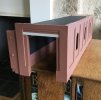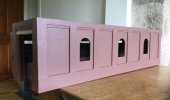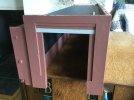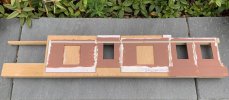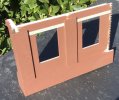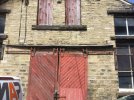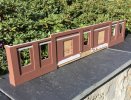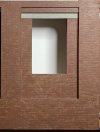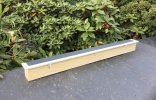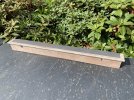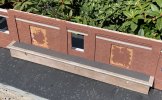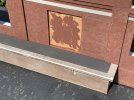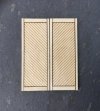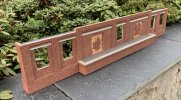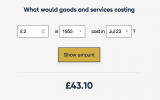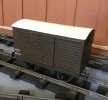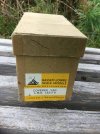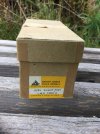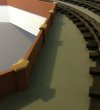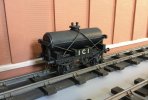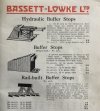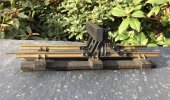I have previously posted photos and given descriptions of a couple of the locomotives I intend using to operate Rivermead Central. To date though, I have said nothing about goods and passenger stock. The first wagons I would like to describe are some made in the 1950s and retailed by Bassett-Lowke. I have about half a dozen of these.
It’s probably easiest to start with what appeared in the Bassett-Lowke catalogues from c.1950 to c.1955 relating to these wagons:
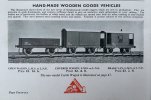
The catalogue description is accurate except the buffers on these wagons are turned blackened brass, not white metal. The buffers are not sprung. The above illustration was used throughout the period these wagons were listed in the catalogue. A couple of points in the description do change from one catalogue to the next; the wheels were sometimes stated to be cast iron, some years they were ‘made from anti-friction metal’. Some years the wagons were listed as being made in the colours of two railway companies (LMS, LNER), other years three companies (additionally, GWR).
I should say I have never seen a GWR example of these wagons and I am sceptical that these actually exist. British Railways versions however definitely were made but were never included in the catalogue.
The LMS merchandise wagon in the above illustration is a little different to the merchandise wagons I have and others I have seen. Perhaps the one in the catalogue illustration was the prototype. The regular production models are clearly shorter and with a shorter wheel base than the merchandise wagon illustrated in the catalogue.
Here are the same three types as in the catalogue illustration photographed at Cavendish Goods earlier today:
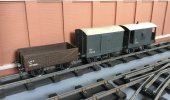
The open wagon and covered van have cast iron wheels, the brake van has alloy wheels. This suggests the changes in the catalogue description regarding the wheels were reflected in the models made. The LNER brake van models always seem to be in grey though I don’t believe the LNER ever used grey for brake vans; an unfortunate error. The bodies of the LMS and LNER brake vans are quite different corresponding to their respective prototypes. The goods van bodies are also different between the two companies. The merchandise wagons are all the same except for livery.
I am not sure how many different running number transfers were made but these seem to be applied randomly to the different vehicle types. By contrast, the transfers for ‘10T’ and ‘12T’ are both used on the merchandise wagons but I have only seen the ‘20T’ transfer on brake vans.
Several of the above points are illustrated by this example of an LNER merchandise wagon which has survived in pristine condition:
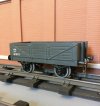
The catalogue listing of ‘open wagon’ gives no indication that the range included both mineral wagons and merchandise wagons, apparently sold for the same price. But both types turn up frequently enough for it to be clear that both were regular production items. The mineral wagon I feel is a particularly nice model:
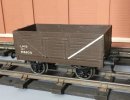
The above example has been fitted with the type of single-link coupling normally fitted to Bassett-Lowke lithographed tinplate wagons. The alteration appears to have been professionally done, quite possibly at the factory prior to sale, perhaps to meet the requirements of a particular customer.
As with the merchandise wagons, the LMS and LNER liveried mineral wagons have identical bodies.
A brief comment about the cattle wagon mentioned in the catalogue excerpt shown above. This had much in common with the wagons just described but the sides and ends were plastic mouldings. These have not lasted well. Every example of the cattle wagon I have ever seen had been affected by shrinkage and distortion of the plastic components and was unuseable.
A few general points about these wooden wagons. By the standards of the time, they are really very nice and look pretty convincing. They were by a large margin the most accurate wooden wagons ever offered by Bassett-Lowke. There wasn’t really a suitable goods loco to haul these wagons included in the post-war Bassett-Lowke range. I also wonder who actually made them. Bassett-Lowke used many suppliers to provide the range of items listed in the company’s catalogues. Whilst I don’t have any definite evidence, I don’t think these wagons were made at the Northampton works. They don’t have a maker’s transfer. The wooden wagon kits offered at the same time build into different models to the ready-to-run vehicles described above. This suggests to me that the kits and the ready-to-run wagons were from different suppliers. The kits, for example, have the same axleguard casting as the pre-war Bassett-Lowke wooden wagons had. I think the kits did come from Northampton.
I would be very happy to hear of any supporting or contrary evidence as to the possible manufacture of these models. Also, has anyone seen a GWR liveried example?
